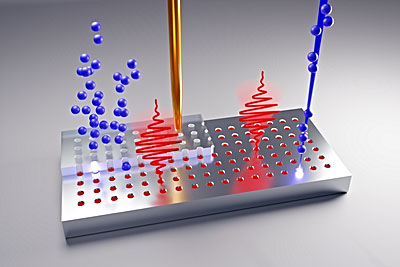Quantum Emitters: Nanoscale Light Sources for Quantum Technologies
What are Quantum Emitters?
Quantum emitters are nanoscale systems that can generate single photons or pairs of entangled photons on demand. These emitters are typically based on the optical transitions of individual quantum systems, such as atoms, molecules, quantum dots, or defects in solid-state materials. Quantum emitters play a crucial role in the development of quantum technologies, including quantum computing, quantum communication, and quantum sensing.

Key Properties of Quantum Emitters
Quantum emitters exhibit several unique properties that distinguish them from classical light sources:
- Single-Photon Emission: Quantum emitters can generate single photons on demand, meaning that they emit exactly one photon at a time. This property is crucial for applications in quantum cryptography and quantum information processing, where the presence of multiple photons can introduce errors and security vulnerabilities.
- Photon Indistinguishability: Photons emitted by an ideal quantum emitter are indistinguishable from each other, having identical spectral, spatial, and temporal properties. This indistinguishability is essential for quantum interference and entanglement, which are the basis for many quantum technologies.
- High Emission Rate: Quantum emitters can have high emission rates, meaning that they can generate single photons at a high repetition rate. This property is important for practical applications, as it enables faster quantum operations and higher data transmission rates.
- Narrow Linewidth: Quantum emitters typically have narrow emission linewidths, which means that the emitted photons have a well-defined frequency and a long coherence time. This property is crucial for achieving high-fidelity quantum operations and long-distance quantum communication.
Types of Quantum Emitters
There are several types of quantum emitters that are actively being researched and developed for various applications:
Quantum Dots
Quantum dots are nanoscale semiconductor crystals that can confine electrons and holes in all three spatial dimensions. When excited by an external stimulus (such as a laser pulse), a quantum dot can emit a single photon as the electron-hole pair recombines. Quantum dots can be fabricated using various semiconductor materials, such as CdSe, InAs, and PbS, and can be engineered to emit photons at specific wavelengths.
Color Centers in Diamond
Color centers in diamond, such as the nitrogen-vacancy (NV) center and the silicon-vacancy (SiV) center, are atomic-scale defects that can act as quantum emitters. These defects consist of a vacancy (missing carbon atom) and an adjacent impurity atom (such as nitrogen or silicon) in the diamond lattice. Color centers can emit single photons with excellent properties, such as high brightness, room-temperature operation, and long spin coherence times, making them promising candidates for quantum sensing and quantum communication applications.
Single Molecules
Single molecules, such as organic dyes and fluorescent proteins, can also serve as quantum emitters. When a single molecule is excited by a laser, it can emit a single photon as it relaxes back to its ground state. Single molecules can be embedded in solid-state matrices or suspended in solution, and their quantum emission properties can be tuned by modifying their chemical structure or local environment.
Trapped Ions and Atoms
Trapped ions and atoms are another class of quantum emitters that have been extensively studied for quantum computing and quantum simulation applications. These systems consist of individual ions or atoms that are confined in electromagnetic traps and can be manipulated using laser fields. When excited by a laser, a trapped ion or atom can emit a single photon, which can be collected and used for quantum communication or quantum information processing.
Applications of Quantum Emitters
Quantum emitters have a wide range of applications in quantum technologies:
Quantum Cryptography
Quantum emitters are the key components of quantum key distribution (QKD) systems, which enable secure communication by exploiting the principles of quantum mechanics. In QKD, single photons generated by quantum emitters are used to transmit secret keys between two parties, ensuring that any eavesdropping attempt can be detected.
Quantum Computing
Quantum emitters can be used as qubits (quantum bits) in quantum computers, where information is processed using the quantum states of single photons or the spin states of trapped ions or atoms. Quantum emitters can also be used to generate entangled photon pairs, which are essential for implementing quantum logic gates and quantum algorithms.
Quantum Sensing
Quantum emitters, particularly color centers in diamond, have emerged as promising sensors for various physical quantities, such as magnetic fields, electric fields, temperature, and pressure. The spin states of these emitters are highly sensitive to their local environment, enabling nanoscale sensing with high spatial resolution and sensitivity.
Challenges and Future Perspectives
Despite the significant progress in the development of quantum emitters, several challenges still need to be addressed. One of the main challenges is the scalability and integration of quantum emitters into practical devices. The fabrication and control of large arrays of identical quantum emitters remain a significant hurdle, particularly for solid-state systems.
Another challenge is the optimization of the emission properties of quantum emitters, such as the single-photon purity, indistinguishability, and emission rate. Researchers are exploring various strategies to improve these properties, including advanced material growth techniques, photonic structures for enhanced light-matter interaction, and active feedback control.
The future of quantum emitters is closely tied to the development of quantum technologies. As quantum computers, quantum communication networks, and quantum sensors become more advanced, the demand for high-performance quantum emitters will continue to grow. Researchers are also exploring new materials and designs for quantum emitters, such as 2D materials, perovskites, and metamaterials, which may offer unique advantages over existing systems.
Further Reading
Journal of Semiconductors, Review on the quantum emitters in two-dimensional materials
Scientific Reports, Towards practical applications of quantum emitters in boron nitride
